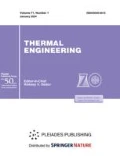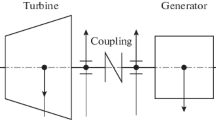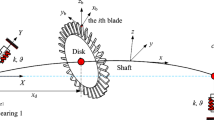Abstract—
The article presents an algorithm for and results from studying the motion of a rotor involving its simultaneous rubbing against the stator elements in the turbine set span and supports. The aim of the study was to develop the mathematical model describing vibration of the rotor resting in a few supports and to select the main assumptions regarding the contact interaction between the rotor and stator that will make it possible to model a real vibrational process that involves rubbing. An abrupt loss of balancing in the rotor’s second span section at the angular rotation speed is taken as the initial disturbance upsetting the turbine set’s normal operation. The case of a constant rotor rotation speed with loss of balancing followed by development of contact interaction between the rotor and stator elements is considered. This scenario seems to be the most plausible because the interaction persists for a short period of time during which the safety system still remains silent in producing the command to disconnect the steam supply to the turbine, and the torque on its shaft remains constant. It is shown that with the adopted clearances in the turbine set span and supports, with the loss of balancing corresponding to detachment of the mass of one turbine blade, and with increased damping in the supports, the rotor motion is accompanied by rubbing in the turbine set supports and span. If the damping coefficient in the supports does not exceed the value of this parameter in the plain bearing oil film, asynchronous reverse whirl of the rotor develops, which is characterized by self-excited vibration caused by the effect of contact interaction forces between the rotor and stator. Owing to consideration of the rotor design features, its frequency characteristics, including the change in the frequency characteristics of the rotor–supports system due to additional reactions arising at the moments in which the rotor comes into contact with the stator, it becomes possible to model the vibration development process not only during strong (when whirl is excited) but also during weak (possible excitation of low-frequency vibration) interactions between the rotor and stator and to analyze the influence of detuning from resonances and other factors on the development of self-excitation processes in systems closer to real ones.


Similar content being viewed by others
REFERENCES
I. Sh. Zagretdinov, A. G. Kostyuk, A. D. Trukhnii, and P. R. Dolzhanskii, “Destruction of the 300-MW turbine-generator unit at the Kashira District Power Station: Causes, consequences, and conclusions,” Therm. Eng. 51, 345–355 (2004).
E. L. Poznyak, “Torsional blow in a shafting in a sudden and severe disbalance,” Mashinovedenie, No. 5, 66–74 (1987).
L. Ya. Banakh, “Some phenomena that occur when the shaft moves in a bearing with a clearance,” Mashinovedenie, No. 1, 70–77 (1965).
A. G. Kostyuk, V. F. Shatokhin, and S. D. Tsimmerman, “Numerical simulation of transient oscillations after abrupt multi-bearing rotor disbalance with the unbalanced rotor moving over the stator,” Aviats.-Kosm. Tekh. Tekhnol., No. 8 (85), 81–93 (2011).
V. F. Shatokhin, Oscillations of Rotors with Rotor-Over-Stator Rolling (Methods of Mathematical Modeling and Software Tools) (Lambert Academic, Dusseldorf, 2016) [in Russian].
V. F. Shatokhin, “Forces exciting generation roll at rotor vibrations when rotor-to-stator rubbing,” Therm. Eng. 64, 480–489 (2017). https://doi.org/10.1134/S0040601517070072
V. F. Shatokhin, “The damping capacity of damping devices during rotor-over-stator rolling,” Therm. Eng. 66, 100–107 (2019). https://doi.org/10.1134/S004060151902006X
A. G. Kostyuk, V. F. Shatokhin, and O. A. Volokhovskaya, “Motion of an imbalanced rotor when it rubs against the stator,” Therm. Eng. 59, 87–95 (2012).
V. F. Shatokhin, Estimated Determination of the Dynamic Characteristics of Multi-Bearing Shafting of High-Capacity Turbine Units on a Foundation, Candidate’s Dissertation in Engineering (Moscow Power Engineering Inst., Moscow, 1972).
A. G. Kostyuk, S. S. Dmitriev, B. N. Petrunin, and A. A. Gusev, “Influence of the operational wear of the stator parts of shroud seals on the economic efficiency of the steam turbines,” Therm. Eng. 65, 11–16 (2018). https://doi.org/10.1134/S0040601518010020
E. L. Poznyak, “Dynamic properties of oil film in plain bearings,” Izv. Akad. Nauk SSSR. Mekh. Mashinostr., No. 6, 53–67 (1961).
Author information
Authors and Affiliations
Corresponding author
Additional information
Translated by V. Filatov
Rights and permissions
About this article
Cite this article
Shatokhin, V.F. Turbine Generator Rotor Vibrations with Rubbing in the Span and Supports. Therm. Eng. 67, 266–270 (2020). https://doi.org/10.1134/S0040601520050092
Received:
Revised:
Accepted:
Published:
Issue Date:
DOI: https://doi.org/10.1134/S0040601520050092




